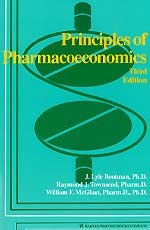
Most Helpful Customer Reviews
1 of 1 people found the following review helpful:
The start of a very interesting field, December 19, 2006
By Lehigh History Student - See all my reviews
This is a very clearly written and excellent account of pharmacoeconomics. If you are looking to get started in this field or a professor considering this book it is a great place to start. There are several other books out there but this one is by far the easiest to read and the one that explains the issues in the least technical manner. I found it very helpful when I was confused and really enjoyed reading it. Highly recommend for those starting out in this field. Comment | Permalink | Was this review helpful to you? (Report this)
11 of 13 people found the following review helpful:
good introduction for biostatisticians and clinicians, March 21, 2001
By Michael R. Chernick "statman13" (Malvern, PA) - See all my reviews
Pharmacoeconomics has become an important discipline in the development and marketing of drugs in the 1990s and it will continue to grow in importance in the 21st Century. Pharmaceutical companies are becoming more aware of the need to gain expertise in this area as they start to use these techniques in clinical trials to help get regulatory approvals and more importantly to convince pharmacies of the value of stocking the products. It is the ever increasing cost of medical care that has led manufacturers of medical devices and pharmaceuticals to the recognition of the need to evaluate products in terms of cost versus effectiveness in addition to the usual efficacy and safety criteria that are standard to regulatory approvals. The regulatory authorities in many countries are also seeing the need for these studies.
The editors write the introductory chapter that provides a brief overview of the topics, presents some of the important literature and introduces the topics for the latter chapters. Other experts in the field were invited to write the other chapters. The coverage is generally very good and it is valuable to see the issues from different perspectives, those of physicians, pharmacists, economists, quality of life specialists, and clinicians. Each specialist covers his or her area well and most chapters have two or more authors.
The disadvantage of this approach is that topics are segmented and some of the material in one chapter is repeated in another. Also the quality of the exposition varies across chapters with some much better than others. In general the coverage of the literature is excellent and several chapters include important real world examples. I found the chapters that included case studies and critiqued them were among the best.
The chapter on health related quality of life is excellent. One of the chapter authors, John Ware was instrumental in the development, validation and use of quality of life instruments including the often used SF-36 questionnaire.
One of the interesting and important points that I got out of the book is the need to consider a perspective for the analysis. Looking at the cost/benefit tradeoffs can differ depending on whether you are looking at it from the patients perspective, the physicians perspective, society's perspective, an HMOs perspective or a pharmacy's perspective. The perspective has an important effect on which costs related to the drug should be included, what comparisons should be made and which type of analysis is needed.
Each methodology is given a separate chapter. There are important but subtle distinctions to be made between the methods and these are more easily recognized through the format the editors have chosen. The first chapter provides an overview and distinctions between the methods, the second covers the international issues and the policies of the regulatory bodies in the US, Canada (and the province of Ottawa) and Australia. Guidelines for pharmacoeconomic studies have been developed in Australia, Canada and Ottawa. Then the four methods of analysis, (1) cost determination and cost analysis, (2) cost-benefit analysis, (3) cost-effectiveness analysis and (4) cost-utility analysis are covered in Chapters 3-6 respectively. Chapter 7 deals with incorporation of health-related quality of life issues. Formal decision analysis and its application to pharmacoeconomic evaluations is given in Chapter 8. Use of epidemiological methods is covered in Chapter 9. Chapter 10 covers how phase III clinical trials generally are run and how these methods can be incorporated in these trials. Chapters 11 through 14 then cover aspects of these methods from different perspectives, at medical centers, in community practice, at managed care organizations, and in the clinical practice of an individual physician. Chapter 15 reviews a few case studies and critiques how the principles are implemented. The appendix is another chapter that deals with the practical issues of implementing these methods.
I was given the book as an introduction to help me become the company expert in this area. I think it was a good start for that purpose. It is clear that methods and principles have been evolving over the past 15 - 20 years with much of the progress over the past 10. The book is a great source for references on where to learn more. I think it gave me some insight into the difficulties of doing pharmacoeconomic studies and also an understanding of the gap between the ideal methods and actual examples in practice.
I think that from the practical point of view there will always be difficulties in identifying and measuring all the relevant costs. Some important costs may be difficult to place on a monetary scale. Still I believe these methods will have a place in filtering out the high cost treatments that have marginal medical benefit over existing lower cost alternatives.
Comment | Permalink | Was this review helpful to you? (Report this)
2 of 2 people found the following review helpful:
important new area in pharmaceutical research, February 7, 2008
By Michael R. Chernick "statman31147" (Holland PA) - See all my reviews
Pharmacoeconomics has become an important discipline in the development and marketing of drugs in the 1990s and it will continue to grow in importance in the 21st Century. Pharmaceutical companies are becoming more aware of the need to gain expertise in this area as they start to use these techniques in clinical trials to help get regulatory approvals and more importantly to convince pharmacies of the value of stocking the products. It is the ever increasing cost of medical care that has led manufacturers of medical devices and pharmaceuticals to the recognition of the need to evaluate products in terms of cost versus effectiveness in addition to the usual efficacy and safety criteria that are standard to regulatory approvals. The regulatory authorities in many countries are also seeing the need for these studies.
The editors write the introductory chapter that provides a brief overview of the topics, presents some of the important literature and introduces the topics for the latter chapters. Other experts in the field were invited to write the other chapters. The coverage is generally very good and it is valuable to see the issues from different perspectives, those of physicians, pharmacists, economists, quality of life specialists, and clinicians. Each specialist covers his or her area well and most chapters have two or more authors.
The disadvantage of this approach is that topics are segmented and some of the material in one chapter is repeated in another. Also the quality of the exposition varies across chapters with some much better than others. In general the coverage of the literature is excellent and several chapters include important real world examples. I found the chapters that included case studies and critiqued them were among the best.
The chapter on health related quality of life is excellent. One of the chapter authors, John Ware was instrumental in the development, validation and use of quality of life instruments including the often used SF-36 questionnaire.
One of the interesting and important points that I got out of the book is the need to consider a perspective for the analysis. Looking at the cost/benefit tradeoffs can differ depending on whether you are looking at it from the patients perspective, the physicians perspective, society's perspective, an HMOs perspective or a pharmacy's perspective. The perspective has an important effect on which costs related to the drug should be included, what comparisons should be made and which type of analysis is needed.
Each methodology is given a separate chapter. There are important but subtle distinctions to be made between the methods and these are more easily recognized through the format the editors have chosen. The first chapter provides an overview and distinctions between the methods, the second covers the international issues and the policies of the regulatory bodies in the US, Canada (and the province of Ottawa) and Australia. Guidelines for pharmacoeconomic studies have been developed in Australia, Canada and Ottawa. Then the four methods of analysis, (1) cost determination and cost analysis, (2) cost-benefit analysis, (3) cost-effectiveness analysis and (4) cost-utility analysis are covered in Chapters 3-6 respectively. Chapter 7 deals with incorporation of health-related quality of life issues. Formal decision analysis and its application to pharmacoeconomic evaluations is given in Chapter 8. Use of epidemiological methods is covered in Chapter 9. Chapter 10 covers how phase III clinical trials generally are run and how these methods can be incorporated in these trials. Chapters 11 through 14 then cover aspects of these methods from different perspectives, at medical centers, in community practice, at managed care organizations, and in the clinical practice of an individual physician. Chapter 15 reviews a few case studies and critiques how the principles are implemented. The appendix is another chapter that deals with the practical issues of implementing these methods.
I was given the book as an introduction to help me become the company expert in this area. I think it was a good start for that purpose. It is clear that methods and principles have been evolving over the past 15 - 20 years with much of the progress over the past 10. The book is a great source for references on where to learn more. I think it gave me some insight into the difficulties of doing pharmacoeconomic studies and also an understanding of the gap between the ideal methods and actual examples in practice.
I think that from the practical point of view there will always be difficulties in identifying and measuring all the relevant costs. Some important costs may be difficult to place on a monetary scale. Still I believe these methods will have a place in filtering out the high cost treatments that have marginal medical benefit over existing lower cost alternatives.
具體描述
讀後感
評分
評分
評分
評分
用戶評價
相關圖書
本站所有內容均為互聯網搜索引擎提供的公開搜索信息,本站不存儲任何數據與內容,任何內容與數據均與本站無關,如有需要請聯繫相關搜索引擎包括但不限於百度,google,bing,sogou 等
© 2025 qciss.net All Rights Reserved. 小哈圖書下載中心 版权所有





















